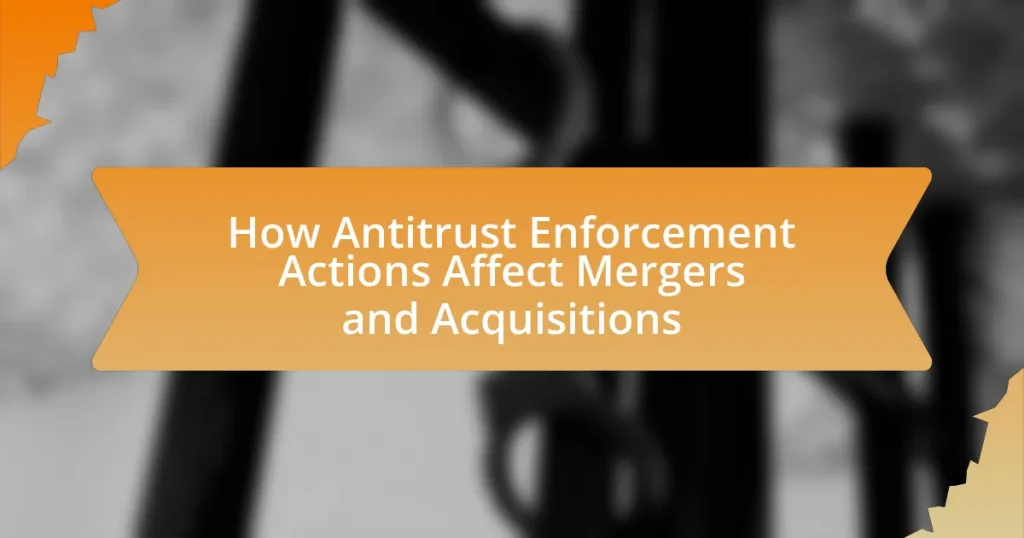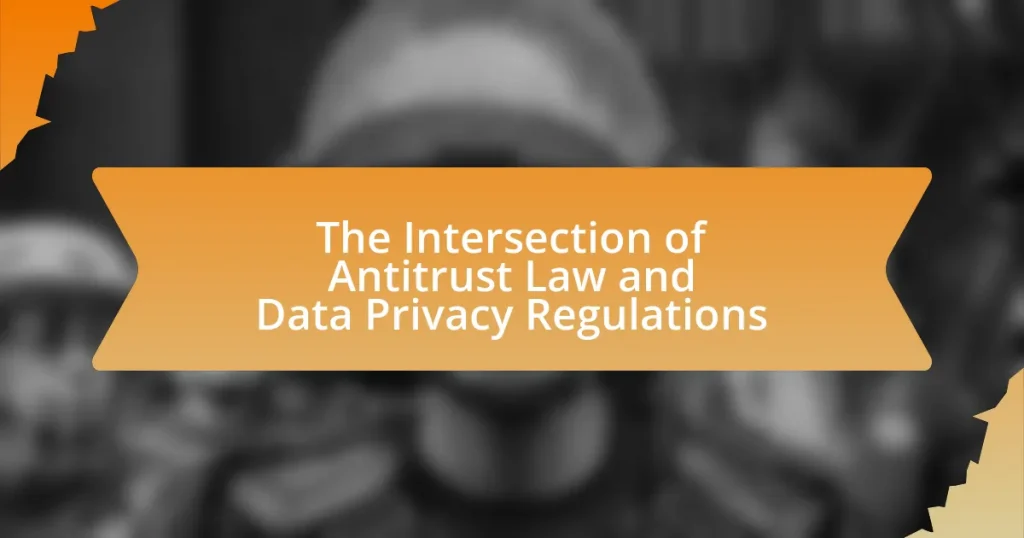Antitrust enforcement actions are legal measures implemented by government authorities to prevent anti-competitive practices and ensure market competition. This article examines how these actions influence mergers and acquisitions, detailing the impact of key antitrust laws such as the Sherman Act and the Clayton Act in the United States. It explores the antitrust review process, the criteria regulators use to evaluate mergers, and the potential outcomes of antitrust scrutiny. Additionally, the article highlights the importance of these actions in protecting consumer interests and maintaining competitive markets, while also discussing strategies companies can employ to navigate antitrust challenges effectively.

What are Antitrust Enforcement Actions?
Antitrust enforcement actions are legal measures taken by government authorities to prevent anti-competitive practices and promote market competition. These actions can include investigations, lawsuits, and penalties against companies that engage in monopolistic behavior, price-fixing, or other practices that harm consumer welfare and market integrity. For example, the U.S. Department of Justice and the Federal Trade Commission actively monitor and challenge mergers and acquisitions that may substantially lessen competition, as seen in cases like the merger between AT&T and Time Warner, which faced significant scrutiny before approval.
How do Antitrust Laws impact business practices?
Antitrust laws significantly impact business practices by prohibiting anti-competitive behavior and promoting market competition. These laws, such as the Sherman Act and the Clayton Act in the United States, prevent monopolies and ensure that companies engage in fair competition. For instance, when a merger is proposed, antitrust authorities evaluate its potential to reduce competition in the market. If a merger is deemed likely to create a monopoly or significantly lessen competition, it may be blocked or require modifications. Historical examples include the 2011 merger attempt between AT&T and T-Mobile, which was rejected by the Department of Justice due to concerns over reduced competition in the telecommunications market. This illustrates how antitrust laws directly influence corporate strategies and decisions regarding mergers and acquisitions.
What are the key antitrust laws in the United States?
The key antitrust laws in the United States are the Sherman Act, the Clayton Act, and the Federal Trade Commission Act. The Sherman Act, enacted in 1890, prohibits monopolistic practices and restraints of trade. The Clayton Act, passed in 1914, addresses specific practices that the Sherman Act does not clearly prohibit, such as price discrimination and certain mergers that may substantially lessen competition. The Federal Trade Commission Act, also established in 1914, created the Federal Trade Commission (FTC) and prohibits unfair or deceptive acts or practices in commerce. These laws collectively aim to promote fair competition and prevent anti-competitive practices in the marketplace.
How do these laws vary across different countries?
Antitrust laws vary significantly across different countries, reflecting diverse economic philosophies and regulatory approaches. For instance, the United States employs a more permissive stance, focusing on consumer welfare and allowing mergers unless they substantially lessen competition, as seen in the Clayton Act of 1914. In contrast, the European Union adopts a stricter approach, emphasizing market structure and competition preservation, as outlined in the EU Merger Regulation, which can block mergers that threaten to create monopolies or significantly impede effective competition. Additionally, countries like China have rapidly evolving antitrust frameworks, with the Anti-Monopoly Law of 2008 emphasizing both consumer protection and market fairness, leading to increased scrutiny of foreign acquisitions. These variations illustrate how cultural, economic, and political factors shape antitrust enforcement globally.
Why are Antitrust Enforcement Actions important for market competition?
Antitrust enforcement actions are crucial for market competition because they prevent monopolistic practices and promote a level playing field among businesses. By investigating and penalizing anti-competitive behavior, such as price-fixing or market allocation, these actions ensure that consumers benefit from fair prices and diverse choices. Historical data shows that effective antitrust enforcement can lead to increased innovation and lower prices; for instance, the breakup of AT&T in the 1980s resulted in a more competitive telecommunications market, which fostered technological advancements and reduced costs for consumers. Thus, antitrust enforcement actions play a vital role in maintaining healthy competition within markets.
What role do these actions play in preventing monopolies?
Antitrust enforcement actions play a critical role in preventing monopolies by scrutinizing and potentially blocking mergers and acquisitions that could significantly reduce competition in the market. These actions are designed to maintain a competitive landscape, ensuring that no single entity can dominate a market to the detriment of consumers and other businesses. For instance, the Federal Trade Commission (FTC) and the Department of Justice (DOJ) evaluate proposed mergers based on their potential to create or enhance market power, as evidenced by cases like the 2018 blocking of the AT&T and Time Warner merger, which was deemed likely to harm competition in the media sector. By actively intervening in such transactions, antitrust authorities help preserve market diversity and protect consumer interests.
How do they protect consumer interests?
Antitrust enforcement actions protect consumer interests by preventing anti-competitive practices that can lead to higher prices, reduced quality, and limited choices. Regulatory bodies, such as the Federal Trade Commission and the Department of Justice in the United States, scrutinize mergers and acquisitions to ensure they do not create monopolies or oligopolies. For instance, in 2020, the DOJ blocked the merger between Sabre and Farelogix, citing concerns that it would harm competition in the travel technology market, thereby safeguarding consumer access to competitive pricing and services. This proactive approach ensures that market dynamics remain favorable for consumers, promoting innovation and fair pricing.

How do Antitrust Enforcement Actions Affect Mergers and Acquisitions?
Antitrust enforcement actions significantly impact mergers and acquisitions by scrutinizing proposed deals to prevent anti-competitive practices. Regulatory bodies, such as the Federal Trade Commission and the Department of Justice in the United States, assess whether a merger would substantially lessen competition or create a monopoly. For instance, in 2020, the DOJ blocked the merger between UnitedHealth Group and Change Healthcare, citing concerns over reduced competition in the healthcare market. Such actions can lead to delays, modifications, or outright rejections of proposed mergers, influencing corporate strategies and market dynamics.
What is the process of antitrust review in M&A transactions?
The process of antitrust review in M&A transactions involves evaluating the potential impact of a merger or acquisition on market competition. Regulatory authorities, such as the Federal Trade Commission (FTC) and the Department of Justice (DOJ) in the United States, assess whether the transaction would create or enhance market power or facilitate its exercise, which could harm consumers through higher prices or reduced innovation.
Initially, companies must notify the relevant authorities of their intent to merge, often submitting detailed documentation about the transaction and its competitive implications. The authorities then conduct a thorough investigation, which may include market analysis, economic modeling, and consultations with industry stakeholders.
If the review identifies potential antitrust concerns, the authorities may challenge the merger, requiring the companies to modify the transaction or abandon it altogether. Historical examples, such as the blocked merger between AT&T and T-Mobile in 2011, illustrate the rigorous nature of this review process, emphasizing the importance of maintaining competitive markets.
What criteria do regulators use to evaluate mergers?
Regulators evaluate mergers primarily based on their potential impact on competition, market concentration, and consumer welfare. They assess whether the merger would create or enhance market power, leading to higher prices, reduced output, or diminished innovation. For instance, the Herfindahl-Hirschman Index (HHI) is often used to measure market concentration, with higher HHI values indicating less competition. Additionally, regulators consider the merger’s effects on barriers to entry for new competitors and the overall economic efficiency. Historical cases, such as the 2011 merger between AT&T and T-Mobile, illustrate how regulators blocked the merger due to concerns over reduced competition and negative impacts on consumers.
How long does the antitrust review process typically take?
The antitrust review process typically takes between six months to two years. This duration can vary based on the complexity of the merger or acquisition, the regulatory environment, and the specific concerns raised during the review. For instance, the Federal Trade Commission (FTC) and the Department of Justice (DOJ) in the United States often conduct thorough investigations that can extend the timeline, especially if significant antitrust issues are identified.
What are the potential outcomes of antitrust scrutiny on M&A?
Antitrust scrutiny on mergers and acquisitions (M&A) can lead to several potential outcomes, including the blocking of the transaction, the imposition of conditions for approval, or the abandonment of the deal by the parties involved. Regulatory bodies, such as the Federal Trade Commission (FTC) and the Department of Justice (DOJ) in the United States, assess whether a proposed merger would substantially lessen competition or create a monopoly. For instance, in 2020, the DOJ successfully blocked the merger between UnitedHealth Group and Change Healthcare, citing concerns over reduced competition in the healthcare sector. Additionally, companies may opt to restructure their deals or divest certain assets to satisfy regulatory concerns, as seen in the merger between T-Mobile and Sprint, which required divestitures to gain approval. These outcomes illustrate the significant impact of antitrust scrutiny on the M&A landscape.
What happens if a merger is blocked by regulators?
If a merger is blocked by regulators, the companies involved cannot proceed with the merger and must abandon their plans. This regulatory intervention typically occurs when authorities determine that the merger would significantly reduce competition, create a monopoly, or harm consumers. For instance, in 2020, the U.S. Department of Justice successfully blocked the merger between American Airlines and JetBlue, citing concerns over reduced competition in the airline industry. As a result, the companies must either revise their merger proposal to address regulatory concerns or pursue alternative strategies for growth.
How can companies modify their proposals to gain approval?
Companies can modify their proposals to gain approval by addressing antitrust concerns directly and demonstrating compliance with regulatory requirements. This can involve restructuring the deal to reduce market concentration, offering divestitures of certain assets, or including commitments to maintain competition in the market. For instance, in 2020, the merger between T-Mobile and Sprint was approved after T-Mobile agreed to divest assets to Dish Network, which helped alleviate concerns about reduced competition in the telecommunications market. By proactively addressing potential antitrust issues, companies can enhance the likelihood of receiving regulatory approval for their mergers and acquisitions.

What are the implications of Antitrust Enforcement Actions on business strategy?
Antitrust enforcement actions significantly impact business strategy by compelling companies to reassess their competitive practices and market positioning. These actions can lead to increased scrutiny of mergers and acquisitions, often resulting in delays, modifications, or outright rejections of proposed deals. For instance, the Federal Trade Commission’s challenge of the merger between AT&T and Time Warner in 2017 exemplifies how regulatory bodies can influence corporate strategies by prioritizing consumer welfare and market competition. Consequently, businesses may adopt more cautious approaches, focusing on compliance and transparency to mitigate legal risks and maintain favorable relationships with regulators.
How should companies prepare for potential antitrust challenges?
Companies should conduct thorough antitrust risk assessments to prepare for potential antitrust challenges. This involves analyzing their market position, understanding relevant antitrust laws, and evaluating past enforcement actions in their industry. For instance, the Federal Trade Commission (FTC) and the Department of Justice (DOJ) have increased scrutiny on mergers and acquisitions, as seen in the 2021 challenge against the merger of Nvidia and Arm, which highlighted concerns about market dominance. By proactively identifying potential issues and consulting with legal experts, companies can develop strategies to mitigate risks and ensure compliance with antitrust regulations.
What strategies can businesses employ to mitigate risks?
Businesses can employ several strategies to mitigate risks, particularly in the context of mergers and acquisitions affected by antitrust enforcement actions. These strategies include conducting thorough due diligence to identify potential regulatory issues, engaging legal experts to navigate antitrust laws, and developing compliance programs to ensure adherence to regulations. For instance, a study by the American Bar Association highlights that companies that proactively assess antitrust risks during the merger process can significantly reduce the likelihood of regulatory challenges. Additionally, businesses can consider structuring transactions to minimize antitrust scrutiny, such as divesting certain assets or forming joint ventures instead of outright acquisitions. These approaches not only help in managing risks but also enhance the likelihood of successful mergers and acquisitions.
How can companies ensure compliance with antitrust laws during M&A?
Companies can ensure compliance with antitrust laws during mergers and acquisitions by conducting thorough pre-merger assessments and engaging legal counsel specializing in antitrust regulations. These assessments involve analyzing market share, competitive effects, and potential anti-competitive practices that may arise from the merger. Legal counsel can provide guidance on regulatory requirements and help navigate the complexities of antitrust laws, which vary by jurisdiction. For instance, the Federal Trade Commission and the Department of Justice in the United States evaluate mergers based on their potential to substantially lessen competition or create a monopoly, as outlined in the Clayton Act. By proactively addressing these factors, companies can mitigate the risk of legal challenges and ensure adherence to antitrust laws.
What lessons can be learned from past antitrust cases in M&A?
Lessons from past antitrust cases in mergers and acquisitions (M&A) emphasize the importance of thorough regulatory scrutiny and the need for companies to assess market impact before proceeding with deals. Historical cases, such as the 2018 AT&T and Time Warner merger, illustrate that even large corporations can face significant challenges if the merger is perceived to reduce competition. The U.S. Department of Justice’s lawsuit against this merger highlighted concerns over market power and consumer choice, ultimately leading to a court ruling that allowed the merger but underscored the necessity for companies to prepare for potential legal hurdles. Additionally, the 2001 merger of AOL and Time Warner serves as a cautionary tale, demonstrating that anticipated synergies may not materialize, leading to long-term financial difficulties. These cases collectively indicate that companies must conduct comprehensive antitrust assessments and consider potential regulatory objections to avoid costly delays or failures in their M&A strategies.
What are some notable examples of successful and unsuccessful mergers?
Notable examples of successful mergers include the merger between Disney and Pixar in 2006, which resulted in a significant increase in animated film revenue and critical acclaim, with Pixar producing blockbuster hits like “Toy Story 3” and “Finding Dory.” In contrast, a notable example of an unsuccessful merger is the 2000 merger between AOL and Time Warner, which resulted in a loss of over $99 billion in market value due to cultural clashes and strategic misalignment. These examples illustrate how mergers can either enhance corporate value or lead to substantial financial losses, often influenced by factors such as integration challenges and market conditions.
How have these cases shaped current antitrust enforcement practices?
Recent antitrust cases have significantly influenced current enforcement practices by establishing stricter scrutiny on mergers and acquisitions. For instance, the U.S. v. Microsoft case in the late 1990s set a precedent for evaluating market dominance and anti-competitive behavior, leading to more rigorous assessments of tech mergers. Additionally, the Federal Trade Commission’s actions against large pharmaceutical mergers have underscored the importance of considering consumer welfare and market competition, resulting in a more cautious approach to approving deals that could harm competition. These cases have prompted regulators to adopt a more proactive stance, emphasizing the need for comprehensive market analysis and the potential long-term impacts of mergers on competition.
What best practices should companies follow when navigating antitrust issues in M&A?
Companies should conduct thorough antitrust due diligence during mergers and acquisitions to identify potential regulatory issues early. This involves analyzing market share, competitive dynamics, and potential overlaps in products or services. Engaging legal experts specializing in antitrust law is crucial, as they can provide insights into compliance with relevant regulations and help navigate complex legal frameworks. Additionally, companies should prepare for potential regulatory scrutiny by developing a robust communication strategy that addresses concerns from regulators and stakeholders. Historical data shows that proactive engagement with antitrust authorities can lead to smoother approval processes, as seen in the merger between AT&T and Time Warner, where early discussions helped mitigate concerns.



